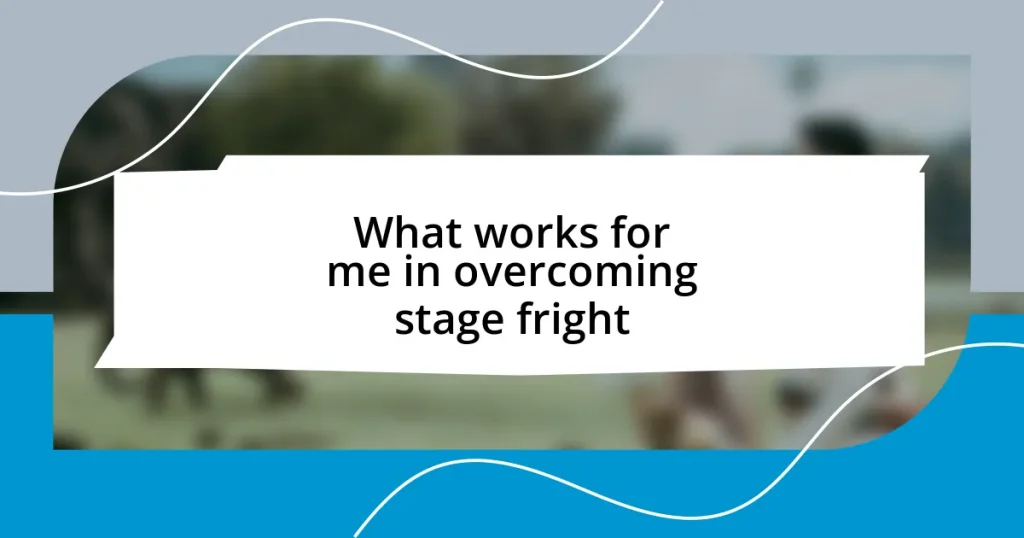Key takeaways:
- Sonata form consists of three main sections: exposition, development, and recapitulation, each contributing to a cohesive musical narrative.
- Thematic development is crucial for creating emotional depth, revealing themes that evolve and engage the listener’s imagination.
- Composers like Mozart, Beethoven, and Chopin exemplify the structure’s potential through unique variations and contrasting themes that enhance storytelling.
- Emotional tension and familiarity in music evoke personal reflections, making sonata form a powerful vehicle for artistic expression and audience connection.

Understanding sonata form basics
Sonata form is fundamentally a musical structure that many composers have cherished for centuries, and I personally find it fascinating how it neatly organizes musical ideas. At its core, this form typically consists of three main sections: exposition, development, and recapitulation. It’s like watching a story unfold—each part building on the previous one, creating tension, and then resolving it. Don’t you feel a sense of anticipation as the music takes you on a journey through these sections?
When I first immersed myself in sonata form, I was struck by its elegance. The exposition introduces contrasting themes that almost feel like characters in a story, while the development section takes these themes on unexpected adventures. I can still remember listening to Beethoven’s symphonies; the way he transformed familiar ideas into something entirely new left a profound impact on my understanding of musical storytelling.
As I dug deeper into this structure, I began to appreciate the seamless interplay of tension and release it encapsulates. There’s a particular thrill in recognizing how a composer manipulates themes and harmonies to evoke strong emotions. Have you ever sat in a concert and felt your heart race during the development, only to be swept back into the comforting familiarity of the recapitulation? That’s the magic of sonata form—a precise blueprint that allows for artistic expression while ensuring the listener feels connected throughout the musical narrative.

Key elements of sonata form
The key elements of sonata form serve as the framework for musical storytelling, allowing composers to explore emotions and ideas deeply. I remember the first time I unlocked the nuances of these sections while analyzing Chopin’s works; it was like seeing the scaffolding of a majestic building. Within sonata form, the exposition brings forth two main themes, usually in contrasting keys, presenting a rich tapestry of melodic material. These themes are then developed in creative ways, adding complexity and engaging the listener’s imagination.
Here are the critical elements of sonata form:
- Exposition: Introduces primary and secondary themes, establishing the main musical ideas.
- Development: Elaborates on these themes, creating tension through key changes and varying motifs.
- Recapitulation: Returns to the initial themes, often restating them in the original key, bringing a satisfying resolution.
When I analyze compositions, I often hear echoes of my own journey in the development section, with its twists and turns resembling my life’s unpredictability. It’s as if the composer takes us through moments of uncertainty and discovery, eventually guiding us back home to the familiar melodies we started with. This unifying structure not only showcases the composer’s genius but also reflects our own emotional experiences.

Analyzing sonata form structure
Analyzing the structure of sonata form reveals a remarkable blend of order and creativity. Each section serves a specific purpose, creating a cohesive musical narrative that resonates deeply with listeners. I vividly remember the first time I analyzed Mozart’s sonatas; the clarity of the exposition lingered in my mind like a bright morning light, each theme dancing around me with distinct colors. It’s thrilling to see how he establishes the framework while still allowing those themes the freedom to evolve during the development.
The transition into the recapitulation feels almost like returning home after an adventurous journey. Often, I find myself emotionally charged as the themes reappear, but this time, there’s a sense of familiarity tinged with growth. It’s as if the musical characters have matured through their travels, and experiencing that transformation is a profound element of the sonata form. Have you ever felt a rush of nostalgia when revisiting familiar melodies? That’s the beauty of this structure—it evokes memories while allowing space for innovation.
To visually represent the structure of sonata form, I’ve put together a simple comparison that highlights its three primary sections and their functions.
| Section | Description |
|---|---|
| Exposition | Introduces main themes in contrasting keys |
| Development | Expands and transforms themes, creating tension |
| Recapitulation | Restates themes returning to the original key |

Common variations in sonata form
Common variations within sonata form can often create unique emotional textures in a composition. For instance, I recently explored Beethoven’s approach to the development section, where he transforms initial themes into somewhat unexpected variations that surprise listeners. This unpredictability amplifies tension while cleverly weaving familiarity with innovation—an experience I find utterly captivating.
One fascinating variation involves the introduction of a new theme during the development phase. I recall my excitement when I noticed how Brahms sometimes incorporated a contrasting theme seemingly out of nowhere, adding depth to the narrative. It’s like an unexpected character developing in a compelling story; it gives both light and shadows, creating a more engaging experience for the audience.
Additionally, the recapitulation can undergo significant changes as well—moving themes around or modifying rhythms. I often think of Schubert’s “Unfinished Symphony,” where he chose to alter the theme’s character just slightly upon reintroduction. It evokes a sense of maturity and complexity that mirrors our own transformations over time. Have you ever noticed how a familiar song can evolve in your mind as you grow? That’s the beauty of these variations—they reflect not just the music but also our life journeys.

Importance of thematic development
Thematic development is the lifeblood of sonata form, breathing life into the musical narrative. When I first tackled the development section in a Beethoven piece, I felt as though I was witnessing a thrilling transformation unfold before my eyes. Each theme didn’t just repeat; they morphed and evolved, like characters in a novel facing new challenges. Have you ever felt that suspense while waiting to see how a story unfolds? That tension in thematic development keeps listeners on the edge of their seats.
What truly strikes me is how these themes can evoke different emotions depending on their treatment. I remember analyzing a Chopin sonata and feeling an almost tangible sense of yearning as the themes twisted into various emotional shades. It’s fascinating how minor adjustments in rhythm or harmony can shift the atmosphere entirely. Can you recall a moment in music where a simple theme, presented in a new light, changed your perception? That’s the power of thematic development—it transforms the familiar into something profoundly impactful.
In my experience, those moments of surprise and revelation are what make thematic development so essential. When a composer skillfully manipulates themes, they challenge listeners to engage more deeply. Reflecting on my time spent with Schubert’s works, I often find myself amazed at how he weaves emotional complexity through thematic variations. Each transformation resonates with personal experiences, making the music feel like a conversation. Isn’t it incredible how music can speak to our experiences in such a vivid way?

Case studies on famous sonatas
Exploring case studies of famous sonatas unveils fascinating insights into their musical architecture. Take, for instance, Mozart’s “Sonata No. 16 in C Major.” The way he constructs the exposition immediately grabs my attention; it’s like a delightful conversation where each theme not only introduces itself but also dances with the other in playful dialogue. Have you ever felt such joy when listening to a piece that just seems to sparkle with life? That’s Mozart for you—his clarity and charm are simply irresistible.
Another compelling case is Beethoven’s “Moonlight Sonata.” The Adagio Sostenuto really struck me during my analysis; the hauntingly beautiful beginning draws you in, almost like a quiet secret being whispered. The way he contrasts that serene atmosphere with sudden bursts of intensity in the later movements showcases his mastery in emotional storytelling. Can you recall a piece that made you feel such a profound hush, only to later set your heart racing? That juxtaposition makes Beethoven’s work a treasure trove for anyone fascinated by the sonata form.
In examining Chopin’s “Piano Sonata No. 2,” I found the unexpected transition from the lyrical second movement to the vigorous Scherzo remarkable. It reminded me of a sudden twist in a riveting plot—just when you think you’ve grasped the essence, the narrative propels you into a whirlwind of energy. It’s moments like these that illustrate how sonatas can convey a rich tapestry of emotions. Don’t you just love those moments in music that leave you breathless and craving more? Chopin beautifully captures that essence, making his sonatas memorable experiences in their own right.
















